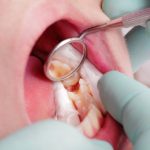
Bonding of restorations to enamel and dentine is part of modern dental practice although dentine bonding is more challenging. Various bonding systems are available and manufactures a consistently aiming to improve their materials. Self-adhesive luting resins were introduced in 2002 and there are now a number of clinical and comparative laboratory studies of self-adhesive luting resins versus other adhesive techniques
The aim of this review was to assess the durability of self-adhesive resin bonding, postoperative sensitivity, and the overall survival rate of indirect restorations compared to total-etch, selective-etch, and self-etch adhesives.
Methods
A protocol for the review was registered in the PSOSPERO database. Searches were conducted in the PubMed/Medline, BioMed Central, Cochrane and Scopus databases. Randomised controlled trials (RCTs) comparing self-adhesive luting resins with total-etch, selective-etch with dentine adhesives, selective etch without dentine adhesives or self-etch adhesives were considered. Two reviewers independently selected studies extracted data and assessed risk of bias using the Cochrane Collaboration Risk of Bias Tool 2 (ROB 2). The main outcomes were the survival rate, postoperative sensitivity, and debonding incidence of indirect restorations.
Results
- 9 RCTs were included, 2 studies involved indirect composite restorations and 7 involved ceramic inlays and partial crowns
- 2 RCTs compared self-adhesive luting resins with the total-etch (etch and rinse) adhesive technique, and one RCT compared self-adhesive luting resins with total-etch and self-etch adhesive systems.
- 2 RCTs compared self-adhesive luting resins with enamel selective-etch and self-etch adhesive systems while 4RCTs studied selective-etch surface pre-treatment before using self-adhesive luting resin.
- 3 RCTs were considered to be at low risk of bias and two RCTs at high risk of bias with 4 RCTs having an unclear risk of bias.
- Meta-analysis found significant difference in the postoperative sensitivity of self-adhesive luting resin to other systems (see table)
| No. of studies | Risk Ratio (95%CI) | |
| total-etch adhesive systems | 3 | 2.05 (0.09 to 44.94 |
| self-etch adhesives | 2 | 1.49 (0.25 to 8.91 |
| selective-etch with dentine bond | 1 | 1.00 (0.06 to 15.55) |
| selective etch without dentine bond | 4 | 0.86 (0.23 to 3.17) |
- For loss of retention (bonding durability) meta-analysis also showed no statistically significant differences for self-adhesive luting resins compared with total-etch adhesive systems. However less debonding was seen with self-adhesive luting resins and selective-etch adhesive system with and without dentine bond (see table below).
| No. of studies | Risk Ratio (95%CI) | |
| total-etch adhesive systems | 3 | 0.03 (0.01 to 7.45) |
| self-etch adhesives | 3 | 0.17 (0.05 to 0.55) |
| selective-etch with dentine bond | 2 | 0.05 (0.01 to 0.39) |
| selective etch without dentine bond | 4 | 0.25 (0.07 to 0.87) |
- Meta-analyses found no statistically significant difference between total-etch luting systems and self-adhesive luting resins but survival rate was higher for self-etch adhesive and selective-etch adhesive systems than for self-adhesive luting resins (see table below).
| No. of studies | Risk Ratio (95%CI) | |
| total-etch adhesive systems | 3 | 0.55 (0.02 to 15.15) |
| self-etch adhesives | 3 | 0.33 (0.16 to 0.68) |
| selective-etch with dentine bond | 2 | 0.11 (0.04 to 0.36) |
| selective etch without dentine bond | 4 | 0.48 (0.26 to 0.91) |
- Meta-analysis demonstrated no statistically significant difference between self-adhesive luting resins and all comparators for tooth integrity or restoration integrity (see table below).
| Risk Ratio (95%CI) | |
| Tooth integrity | |
| total-etch adhesive systems | 0.16 (0.20 to 1.30) |
| self-etch adhesives | 0.50 (0.13 to 71.92) |
| selective-etch with dentine bond | 0.50 (0.13 to 71.92) |
| selective etch without dentine bond | 0.29 (0.06 to 1.34) |
| Restoration integrity | |
| total-etch adhesive systems | 1.06 (0.76 to 1.48) |
| self-etch adhesives | 0.27 (0.20 to 1.58) |
| selective-etch with dentine bond | 0.24 (0.05 to 1.16) |
| selective etch without dentine bond | 0.73 (0.36 to 1.47) |
- Marginal integrity
- The marginal integrity of restorations luted with total-etch adhesive systems was significantly better than the restorations luted with self-adhesive luting resins RR =0.51 (95%CI: 0.34 to 0.76).
- Enamel selective-etch adhesive system with dentine adhesive showed statistically significantly better marginal integrity than self-adhesive luting resins RR = 4.50 (95%CI:1.02 to 19.79).
- Single-step self- adhesive luting resin exhibited no statistically significant difference to self-etch adhesive system RR= 1.20 (95%CI: 0.54 to 2.53) or enamel selective-etch without dentin adhesive RR= 0.58 (95%CI: 0.24 to 1.44).
Conclusions
The authors concluded: –
Postoperative sensitivity might not be affected by the adhesive protocol. In relatively short observation, total-etch revealed comparable survival to self-adhesive luting resins for intracoronal restorations. Self-etch and selective etch adhesives exhibited the best clinical outcomes, followed by selective etch without dentine adhesives. Selective etch, and self-etch adhesives are preferable to self-adhesive resins.
Comments
The authors have preregistered a protocol on the PROSPERO database and searched a good range of relevant databases. 9 relatively small RCTs were identified involving between 10-50 patients and 24 to 150 restorations per study with follow up ranging between 1 – 6.5 years. Meta-analyses were conducted for a number of outcomes for the various agents used with some statistically significant differences being identified. However, these finding should be interpreted cautiously and most of the meta-analyses were conducted on small number of studies and only 3 of the included studies were considered to be at low risk of bias.
Links
Primary Paper
Alghauli MA, Alqutaibi AY, Wille S, Kern M. Clinical reliability of self-adhesive luting resins compared to other adhesive procedures: A systematic review and meta-analysis. J Dent. 2023 Feb;129:104394. doi: 10.1016/j.jdent.2022.104394. Epub 2022 Dec 22. PMID: 36566829.
Other references
Dental Elf – 11th Jul 2020
Improving the bond between glass ceramics and resin-based materials: Does an adhesive layer help?
